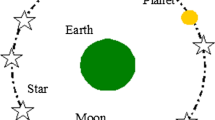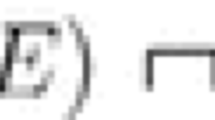Abstract
Zeno's paradoxes of motion and the semantic paradoxes of the Liar have long been thought to have metaphorical affinities. There are, in fact, isomorphisms between variations of Zeno's paradoxes and variations of the Liar paradox in infinite-valued logic. Representing these paradoxes in dynamical systems theory reveals fractal images and provides other geometric ways of visualizing and conceptualizing the paradoxes.
Similar content being viewed by others
REFERENCES
Barnsley, M. (1988), Fractals Everywhere, Academic Press, San Diego, CA.
Barwise, J. and Etchemendy, J. (1987), The Liar, Oxford University Press, New York.
Burge, T. (1982), The Liar paradox: Tangles and chains, Philosophical Studies 41, 353–366. Reprinted in Martin (1984), 83–117.
Carroll, L. (Charles Dodgson) (1895), What the Tortoise said to Achilles, Mind, N. S. 4, 278–280.
Church, A. (1956), Introduction to Mathematical Logic, Vol. 1, Princeton University Press, Princeton, NJ.
Conway, J. H. (1976), On Numbers and Games, Academic Press, San Diego, CA.
Curry, H. B. (1941), The paradox of Kleene and Rosser, Trans. Amer. Math. Soc. 50, 454–516.
Devaney, R. L. (1989), An Introduction to Chaotic Dynamical Systems, 2nd edition, Addison-Wesley, Menlo Park, CA.
van Fraassen, B. (1972), Inference and Self-Reference, in: Davidson and Harman (eds.), Semantics of Natural Language, D. Reidel, Dordrecht, pp. 695–708.
Gardner, M. (1972), The binary Gray code, Scientific American 277 (August), 106 ff.
Gupta, A. (1982), Truth and paradox, J. Phil. Logic 11, 1–60.
Herzberger, H. (1982), Notes on naive semantics, J. Phil. Logic 11, 61–102.
Kleene, S. C. (1936), λ-definability and recursiveness, Duke Math. J. 2, 340–353.
Kleene, S. C. and Barkley, J. R. (1935), The inconsistency of certain formal logics, Ann. Math. 36, 630–636.
Knuth, D. E. (1974), Surreal Numbers, Addison-Wesley, Menlo Park, CA.
Mar, G. and Grim, P. (1991), Pattern and chaos: new images in the semantics of paradox, Noûs 25, 659–693.
Martin, R. L. (1984), Recent Essays on Truth and the Liar Paradox, Oxford University Press, New York.
May, R. (1976), Simple mathematical models with very complicated dynamics, Nature 261, 459–467.
Peitgen, H.-O. and Saupe, D. (eds.) (1988), The Science of Fractal Images, Springer-Verlag, New York.
Rescher, N. (1969), Multi-valued Logic, McGraw-Hill, New York.
Salmon, W. (1970), Zeno's Paradoxes, Bobbs-Merrill, Indianapolis, IN.
Schroeder, M. (1991), Fractals, Chaos, Power Laws, W. H. Freeman, New York.
Scott, K. (1966), John Buridan: Sophisms on Meaning and Truth, Appleton-Century-Crofts, New York.
Shulman, P. (1995), Infinity plus one, and the surreal numbers, Discover 16, 96–105.
Skryms, B. (1982), Intensional aspects of semantical self-reference, in: Martin (1984), pp. 119–131.
St. Denis, P. and Grim, P. (1997), Fractal images of formal systems, J. Phil. Logic 26, 181–222.
Author information
Authors and Affiliations
Rights and permissions
About this article
Cite this article
Mar, G., Denis, P.S. What the Liar Taught Achilles. Journal of Philosophical Logic 28, 29–46 (1999). https://doi.org/10.1023/A:1004399631475
Issue Date:
DOI: https://doi.org/10.1023/A:1004399631475




